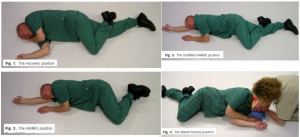05/04/2016
Immobiliser le rachis: Comme il faut !
Safety of the lateral trauma position in cervical spine injuries: a cadaver model study
Hyldmo PK et Al. Acta Anaesthesiol Scand. 2016 Mar 7. doi: 10.1111/aas.12714.
__________________________
Bien immobiliser un rachis avec la bonne position. Lire aussi 1, 2, 3
__________________________
Background: Endotracheal intubation is not always an option for unconscious trauma patients. Prehospital personnel are then faced with the dilemma of maintaining an adequate airway without risking deleterious movement of a potentially unstable cervical spine. To address these two concerns various alternatives to the classical recovery position have been developed. This study aims to determine the amount of motion induced by the recovery position, two versions of the HAINES (High Arm IN Endangered Spine) position, and the novel lateral trauma position (LTP).
Method: We surgically created global cervical instability between the C5 and C6 vertebrae in five fresh cadavers. We measured the rotational and translational (linear) range of motion during the different maneuvers using an electromagnetic tracking device and compared the results using a general linear mixed model (GLMM) for regression.

Results:
In the recovery position, the range of motion for lateral bending was 11.9°. While both HAINES positions caused a similar range of motion, the motion caused by the LTP was 2.6° less (P = 0.037). The linear axial range of motion in the recovery position was 13.0 mm. In comparison, the HAINES 1 and 2 positions showed significantly less motion ( 5.8 and 4.6 mm, respectively), while the LTP did not ( 4.0 mm, P = 0.067).
Conclusion: Our results indicate that in unconscious trauma patients, the LTP or one of the two HAINES techniques is preferable to the standard recovery position in cases of an unstable cervical spine injury.
| Tags : rachis

Les commentaires sont fermés.